

Petunia Bedding Plants
A Bedding Plant is a flowering plant that is used in the garden to give a few months’ display of colour. It can be planted in a flower bed, a border or even a container/hanging basket.
Most bedding plants are used for either summer or spring flowering. Some, such as Pansies, will give a bit of colour through the winter as well.
Bedding plants can be used between existing mature plants such as shrubs and Perennials. Bedding Plants are normally take out after flowering and either composted or put in the rubbish bin.
Most of the colour in most gardens comes from bedding plants, and include marigolds, geraniums, fuchsias, petunias, busy lizzies, alyssum and lobelia.
This is a large section
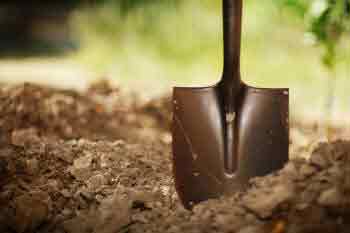
Prepare the soil
Your bedding plants with fare better if the soil is well prepared beforehand, rather than trying to 'excavate' through a crusty old soil surface with a trowel. Far better to dig the area over first.
If your bedding plants are going into a container, or hanging basket, you can skip this section and relax!
Good soil preparation is necessary to get the plants off to a good start. Most bedding plants will have a fine root system, so will appreciate any work you do to help them get established in a good crumbly soil surface.

Bedding Plants
More bedding plants are lost through careless planting than by pests or diseases. If you want success with your bedding plants, then the planting part of the operation must be done properly.
Then you will be sure that your plants are off to a good start and will flower not too long after planting. There are a few things to bear in mind before you set about planting your bedding plants. Poor planting can set the plant back a few weeks or more as a result of stress! Yes, plants can also suffer stress!
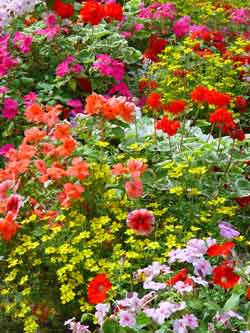
Bedding Plants
As we get into the euphoria – for some – of the advantages of global warming or climate change, we seem to be getting more confident about the times we plant out our summer bedding. And also try to grow some plants which were considered too tender just ten years ago.
Easter of course is the big time for gardening to begin. However, Easter is a movable festival from year to year, and does not coincide with the current seasonal weather we are having at any given time! Easter can be a beautiful warm period – it can also be cold frosty weather. It is a religious festival. It is not a signal that you can plant your summer bedding. The weather conditions will dictate that!
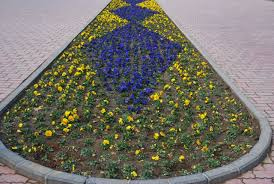
Build a Seed Bed
A seed bed can be used for plants that take a long time to mature - such as hardy cyclamen!
Long before garden centres became the norm for gardeners, most respectable gardens had a seed bed. The seed bed was used for raising many different plants – ornamental and vegetable – from seeds.

Sowing seeds
The normal practice of sowing seeds in a seed bed, is to sow the seeds in rows. The rows can be as long as you like, and simply made by pressing the back of a rake head into the soil along a line – either with string or a straight board to make it neat!
You should end up with a neat V shaped row. The seeds normally germinate successfully, but then you have to look after them of course!
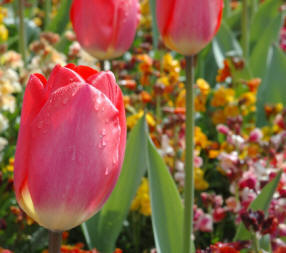
Tulip Bedding Plants
There is a wide range of plants that can be grown to give flower colour in early spring. Sometimes called winter bedding, but spring bedding is a more accurate description.
Some plants will have flowers in the middle of winter – notably the winter flowering pansies. Some primroses and polyanthus will also have flower, but the winter pansies are best.

Cleome
Most of the bright flowers in flower beds are half hardy annuals, so there is no problem finding a good selection.
If you are new to gardening, then a good garden centre or nursery is best choice as most of these will have good descriptive colour labels these days.
Seed catalogues are increasingly selling small plants (plugs) which will soon grow after being planted out in the garden. Don't buy mini- plants too early unless you have somewhere to keep them growing!
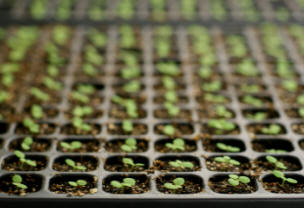
Seedlings
Half hardy annuals for summer bedding are normally sown into seed boxes – or sometimes pots – between January and March. Seeds of half hardy annuals are sown in seed compost, although multi-purpose is ok for larger seeds.
They will need to be kept warm to germinate them, and also to grow them on into healthy seedlings and then plants ready for the garden.

Sunflower
How to sow hardy annual flowers. Make sure that the ground – bed – is well prepared and not too lumpy. Mark out some areas of irregular shape on the soil and simply sprinkle the seed thinly. Bear in mind that those small seeds can produce a plant that is 12in (30cm) across in a few months!
Read the packet, and understand just how big each plant can grow. Of course we all ‘over-sow’ for safety so don’t think of placing seeds individually where you want the plants to grow – scatter them well. Hardy Annuals normally have a good ‘helping’ of seeds in the packet to allow for a bit of over-indulgence!

French Marigold
Most seed catalogues will have a good selection of hardy annuals that can simply be sown into their flowering positions in the garden.
It is probably easier to see the list in a catalogue - rather than having to look through the seed racks in a garden centre, which tend to be just a mass of colour - arranged alphabetically - no help!
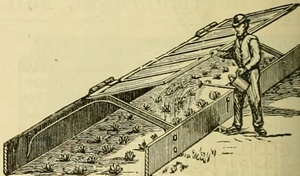
Hardening Off
Plants which have been raised in heated conditions need to be ‘Hardened Off’ before planting into garden or containers. Just think what it is like when you visit a foreign country with different temperatures to what you are used to. If you have good information, you will go to your holiday country – either with fewer or more clothes.
You will be prepared. No such luck for a young seedling! It has to depend upon you to carefully acclimatize it to its new home. It will need to be hardened off!

Geraniums - Pelargoniums
Geraniums (Pelargoniums) can be dug up be dug up after they have finished flowering in the autumn. You can over-winter them easily so that they are available for the next year.
There are several ways to overwinter your geraniums, but we find the best way is to plant them into boxes or pots in a multi-purpose compost. (Take off all of the faded flower stems and yellowing leaves).
You can then ‘store’ your geraniums in winter. Use pots or boxes in a cool place – no heat necessary – with good light.
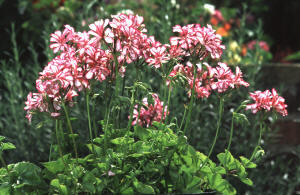
Pelargonium Mexicana
Whilst the propagation of Geraniums (Pelargoniums) is increasingly being done by seed sowing, the traditional way of taking cuttings of Geraniums is a good way of ensuring that you get a supply of plants which are in all ways identical to the parent. Taking Geranium Cuttings is a cost effective way to ensure more plants, though growing geraniums from seed is also an option.
This is not the case with saved seed where the young seedlings are often inferior, and not always true to type. Taking geranium cuttings ensures that your new plant will be the same as the parent.

Geraniums Haleakala
You can grow geraniums from seed quite easily – provided you can give the seeds enough heat for germination. Most seed catalogues – or garden centre seed racks – will have a wide range of geranium seeds. Always go for F1 types if there is a choice.
To get them ready as plants for planting in early summer, you will need to sow the seeds in December January or February. Geranium seeds sown after this will be much later flowering.
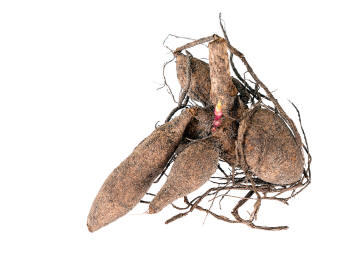
Dahlia Bulb
Dahlias like the one in the image, can be kept through the winter with a little bit of care.
Dahlias are tender plants and need special treatment in the winter months if you wish to keep them from year to year – or maybe even grow new plants from them in the spring. It is easy to keep dahlia plants through the winter.

Petunias
Summer in the garden would not seem the same without Petunia flower gracing flower beds, pots and containers, widow boxes and hanging baskets. They really are that versatile and are one of the most important of all summer bedding plants. As with all things garden plants and flowers, you need to know how to take care of Petunias. Sow and grow then see what happens, works well, but for a mass of Petunia flowers throughout the summer a little bit of extra petunia care goes a long way. You will be well rewarded. Petunia flowers are sun lovers; no getting away from that; with a summer downpour of rain leaving them as bedraggled as we would be without protection.
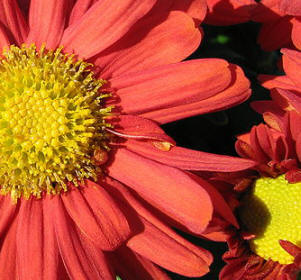
Red Chrysanthemum
When your chrysanthemums have finished flowering in the late autumn, they can be dug up and stored for the following year. It is easy to overwinter Chrysanthemums.
Simply dig up the plants and cut back all the stems to about 6in (150mm). Place the chrysanthemums in a box or tray, and cover with soil or compost and store them in a cool, frost-free place for the winter.